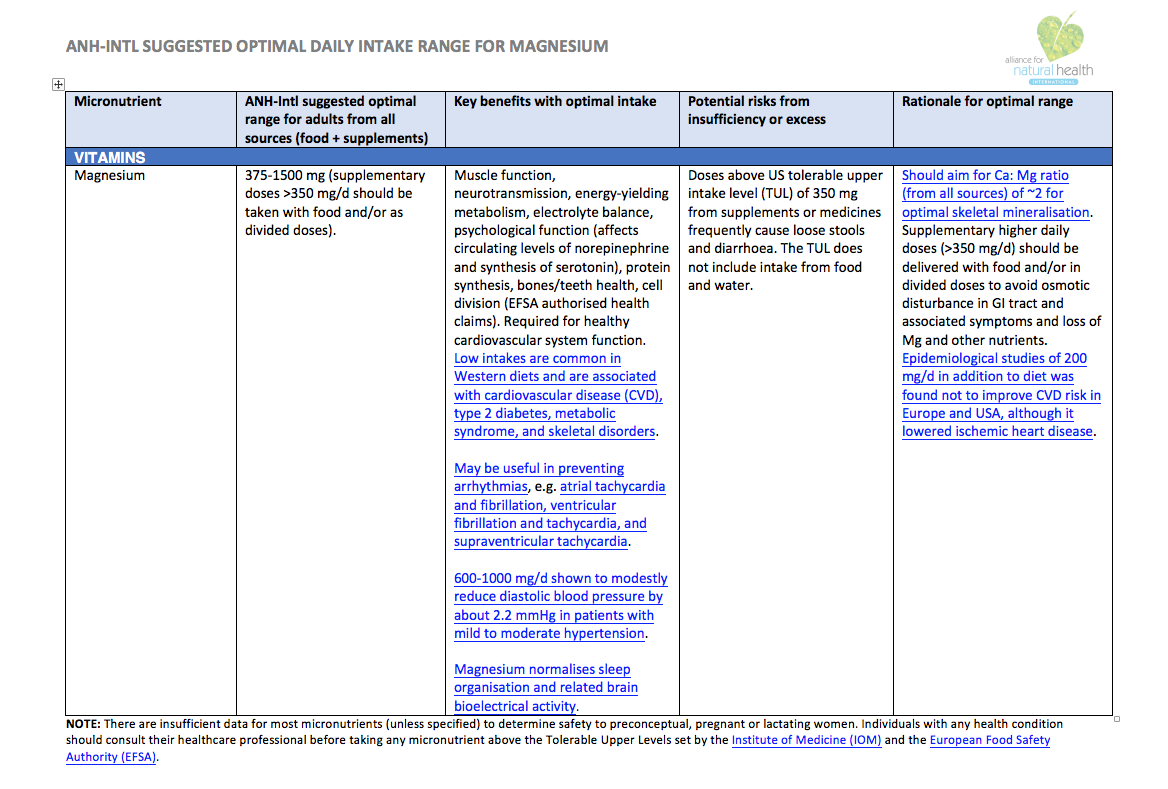Content Sections
If you’ve followed our work for any length of time, you’ll know we’re no strangers to the scientific antics of Germany’s Federal Institute for Risk Assessment (BfR) when it comes to ludicrously low vitamin and mineral levels. Since its first attempt at setting maximum vitamin and mineral levels for food supplements in Germany back in 2005, ANH-Intl has repeatedly shown that its data is “meaningless for the majority of the population”. Well, BfR is at it again — this time with magnesium, one of the most essential minerals for life, needed for bone health and muscle contraction, as well as over 300 biochemical reactions in the body.
Yesterday BfR released a new opinion stating that the maximum daily level for magnesium in food supplements should not exceed 250 mg. We’d not waste our or your time considering this opinion or writing about it, if the BfR didn’t hold a fair amount of sway in Europe, with the European Commission (EC), the European Food Safety Authority (EFSA) and with many EU Member States that view Germany as the micronutrient expert country. Germany has after all spawned pharmaceutical giants like Merck, Bayer and BASF. Interestingly, the latter were among the post-WWII spin-offs from IG Farben, the company that made Zycklon-B used in the gas chambers during the holocaust.
Why is magnesium so essential?
Magnesium is a cofactor in more than 300 enzyme systems that are needed to maintain life and health, from protein synthesis, to muscle and nerve function, blood glucose control, and blood pressure regulation. Magnesium is also needed to produce energy. It contributes to the structural development of bone and is required to make DNA, RNA and the antioxidant, glutathione, key for phase II detoxification. Magnesium is involved in nerve impulse conduction, muscle contraction, and crucially, maintaining normal heart rhythm.
An adult body contains stores of around 25 g magnesium, with about half of this in the bones and almost all the rest in soft tissues including muscles. Whilst magnesium levels are usually measured in blood, there’s actually less than 1% of total magnesium in blood serum. A recent paper highlights the fact that serum magnesium levels do not accurately reflect body magnesium stores, and chronic magnesium deficiency is not widely recognised.
BfR’s beef with magnesium
According to BfR President Prof Dr Andreas Hensel, "Food supplements are in vogue, and many people believe that they can provide health benefits. But the consumption of food supplements may also be associated with health risks. The best nutritional strategy basically involves a balanced and varied diet with plenty of fruit and vegetables. Such a diet supplies a healthy body with all essential substances. In most cases, therefore, food supplements are superfluous."
One senses that the BfR would prefer people to rely on licensed drugs, despite these being the third leading cause of death after heart disease and cancer. Ironically, increasing magnesium status to well above standard reference levels is one of the most reliable ways of reducing death from heart disease (see below).

The health risk that BfR references with regard supplemental magnesium is loose bowels – mild diarrhoea. Its answer to this perceived problem is that food supplements are not necessary because a balanced and varied diet with plenty of fruit and vegetables supplies a healthy body with sufficient magnesium. In its view, this is the same for athletes and the active.
Table 1 provides examples of magnesium-rich foods and Table 2 considers risks and benefits of magnesium, as well as ANH-Intl's view on the optimal therapeutic intake range for the mineral.
Table 1. Magnesium amounts in magnesium-containing foods. (Source: National Institutes for Health, USDA Nutrient Database)

Table 2. ANH-Intl’s suggested optimal intake range for magnesium from all sources (food and supplements).
How much is enough?
The current commonly-used clinical reference range in conventional medicine for circulating magnesium in serum (blood) is 0.75 – 1.25 mmol/L, yet levels as low as 0.66 mmol/L are generally accepted as normal. Integrative and functional medicine practitioners are more focused on optimal amounts for health, rather than just adequacy to prevent life-threatening deficiency. As such, optimal ranges are typically significantly higher, such as 1.00 – 1.25 mmol/L (Table 3).
Table 3. Laboratory reference ranges for circulating magnesium (serum).

We spoke to Jonathan Cohen, Director of the FunctionalDX blood chemistry screen, who told us, “After seeing hundreds of tests, I recall no more than 1 to 1.5% of all tests I have seen ever showing a plasma level over 1.0 mmol/L. The vast majority tend on average to fall between 0.75 and 0.85 mmol/L”.
Cohen, himself an integrative medicine practitioner of many years standing, went on to say, “If I was to go out on a limb I would suggest that one would have 2 standards; for the healthy and the unwell, who definitely will need additional magnesium. Any standardisation lower than what we have now is a potential health risk in itself”.
It should also be noted that while athletes, especially endurance athletes, will typically be viewed as healthy, in order to maintain 'normal' or 'optimal' ranges in serum, their intake might need to be much higher than a normal person. That is because magnesium use in muscle fibres and, hence, its removal from body stores, will tend to greatly exceed that of a non-athlete.
ANH-Intl’s concerns over BfR’s opinion
We have a number of major concerns over BfR's opinion:
- BfR has delivered its opinion to limit magnesium from supplements to 250 mg of elemental magnesium per day using, as its basis, data from the forms most likely to yield this effect (e.g. magnesium sulphate or oxide) and the amount based on a single serving from supplements. The opinion ignores the effects of divided doses during a day from other forms, this being the common way in which magnesium status is improved among those with higher requirements and/or low status.
- There is no mention of the different forms of magnesium that exert very different effects, e.g. magnesium sulphate (Epsom salts) or oxide, the least preferred forms, versus magnesium bisglycinate, taurate, malate or chloride, all of which have different benefits and usages and are greatly preferred in supplemental form. There are currently 21 different forms of magnesium authorised for use in Europe under the EU Food Supplements Directive. Magnesium oxide, the form typically used in supermarket and pharmacy multis, and along with Epsom salts (magnesium sulphate), are the forms with the most potential to cause diarrhoea (through osmotic dysregulation in the gut). Many of the forms used or recommended by nutritional and integrative medicine practitioners are much gentler on the gut and in divided doses, yield zero risk and multiple benefits.
- BfR does not appear to acknowledge that risks and benefits overlap, and therefore by using regulation to eliminate risk from the most risky form among the most sensitive population groups, benefit to the majority would also be eliminated. This principle of overlapping risks and benefits for micronutrients, and its implication for regulation, was first elucidated by ANH’s founder, Robert Verkerk PhD, in a peer-reviewed journal article published in Toxicology in 2010.
- Sports enthusiasts and elite athletes, particularly those involved in endurance exercise, have a much greater requirement for magnesium than non-athletes owing to the mineral's key role in muscle contraction. To perform optimally, these individuals are often dependent on supplementary (and dermally applied) magnesium to maintain levels and avoid cramps. In contrast to the inappropriate remarks made by Prof Dr Dr Alfonso Lampen, Head of Food Safety for the BfR, in the BfR video on magnesium, endurance athletes cannot consume the necessary amounts of fruits and vegetables to maintain optimal status, and certainly not during competition.
- Most of the therapeutically valuable forms of magnesium (e.g. citrate, taurate, malate, biglycinate) are bulky ingredients in their supplemental forms, with magnesium levels generally comprising between 12% and 17% of the magnesium salt or chelate. Therefore cheap multivitamin/mineral products available in supermarkets and pharmacies e.g. Centrum, Sanatogen and Seven Seas, typically contain magnesium oxide, nutritionally, one of the least useful forms for delivering magnesium (and one of the forms with the greatest likelihood of causing diarrhoea).
- Lowered levels of magnesium creates an increased risk that calcium won’t be adequately buffered, which in turn creates the potential for calcium influx into cells and with it the increase risk of cell death and inflammatory ‘cell danger’ responses. Low grade chronic inflammation is at the heart of all chronic disease.
- Circulating magnesium levels are not a good guide for levels of magnesium in body stores. This means a lot of the research that BfR has used to study intake and serum levels is unreliable, with clinicians often having a very different view of magnesium requirements for different individuals as compared with researchers with no clinical experience.
- Magnesium deficiency is a major source of preventable disease, especially coronary heart disease. A recently published meta-analysis from China confirms the well-known inverse association between incidence of coronary heart disease, hypertension and even type 2 diabetes and magnesium status.
Table 4. Magnesium levels in common supermarket/pharmacy multis, manufactured and distributed by Pharma companies

The key take-homes?
- Don’t be frightened off taking supplemental magnesium, especially if your diet isn’t chock full of plant foods, which include plenty of dark green leafy vegetables
- Do take your magnesium supplements alongside food and if you want to take more than 250 mg, do so in divided doses (at least 3 hours apart)
- Choose your form of magnesium carefully
- If you need personalised advice, find an integrative/functional medicine practitioner
- If you want to estimate your magnesium status - and find out more about the science on magnesium, visit the website of the Center for Magnesium Research & Education.









Comments
your voice counts
14 December 2017 at 8:08 am
As a kinesiologist and nutritional therapist, I have consistently found that magnesium chloride flakes in the bath have given the best results for increasing magnesium and balancing high calcium, this being proven by hair tissue mineral analysis. I wonder how any restrictions on dosage would effect transdermal use as dosage absorbed cannot really be measured. Hopefully it will escape this restriction as it is not taken orally. Most often I have positive testing for 750g flakes per bath 2-3 times per week which usually tests for reducing to 500g 1-2 times per week after 1-2 months depending on if there are any factors depleting magnesium such as medication, stress, etc. That is a far cry from 250mg!
14 December 2017 at 8:40 am
Magnesium sulphate (Epsom salt) is sold at pharmacies as a laxative(!). The geniuses at BfR have discovered that a laxative has laxative effects. Bravo. And then they want to use that as a pretext for restricting all molecular forms of magnesium. As far as I know, no supplement makers use magnesium sulphate as an ingredient. The BfR's intellectually dishonest fake science is shameful.
14 December 2017 at 9:54 am
I need magnesium to stop my ankles being painfull at night. No problems with the gut.
Why is there such a fuss made about vitamins and minerals ? How many deaths occur each year from over dose of theses items? Compare it with the 100,000 of deaths caused by big pharma drugs in the USA plus big numbers in Europe. Big pharma needs much more controling than vitamins and minerals.
14 December 2017 at 9:45 pm
Quote from BfR above: "The best nutritional strategy basically involves a balanced and varied diet with plenty of fruit and vegetables. Such a diet supplies a healthy body with all essential substances. In most cases, therefore, food supplements are superfluous.”
However, since 1940 the vitamin and mineral content of fruit, vegetables and meat has gone down decade by decade as a result of continuous mono cropping. This means that fruit and vegetables no longer provide all essential substances. There is an old British statement in regard to those who do not speak from reality: "They must have their heads in cloud cuckoo land." Or a paraphrase from an Native American saying: BfR "speaks with forked tongue'.
Sources:
Miniistry Agriculture Fishes & Farming data for 1940 to 1991 as abstracted by David Thoms in The Inside-Story November 2002 pg 4
See also: Berger, Paul 1997 The Healing Power of Minerals, Special Nutrients & Trace Elements: Prima Publishing USA.
15 December 2017 at 9:32 pm
Thank you ANH for exposing the narrowness of BfM tunnel vision. A very helpful article. Do you consider magnesium stearate a form of Mg likely to create laxative effects or otherwise?. I had thought that rather than deliberate Mg supplementation the main concern was use of Mg stearate in many foods and supplements as an excipient which according to FAO/WHO adds on average 240mg/day of Mg to the diet.
15 December 2017 at 9:39 pm
There are products on the market which are prepared as oil based sprays for absorption through the skin, as one practitioner has found that absorption through the skin when in a bath is as effective as any other method but does not produce the adverse effects in the gut so it would indicate that the best method of supplementing the level of magnesium in the body is by absorption through the skin.
16 December 2017 at 3:02 pm
I am a nutritional therapist and have been using transdermal magnesium (citrate or glycinate) for the last couple of months in an attempt to address health issues which I was unable to resolve with supplementation - I suspect because of gut issues. My thyroid which was underfunctioning has come back within the normal range, my sleep pattern has improved, I have lowered my B. P. and my heart palpitations have stopped. I feel like a different person. My doctor's approach was beta-blockers!
Hopefully this ruling will not go ahead but if it does let's hope we can find ways to circumvent it or boost our magnesium intake.
Your voice counts
We welcome your comments and are very interested in your point of view, but we ask that you keep them relevant to the article, that they be civil and without commercial links. All comments are moderated prior to being published. We reserve the right to edit or not publish comments that we consider abusive or offensive.
There is extra content here from a third party provider. You will be unable to see this content unless you agree to allow Content Cookies. Cookie Preferences